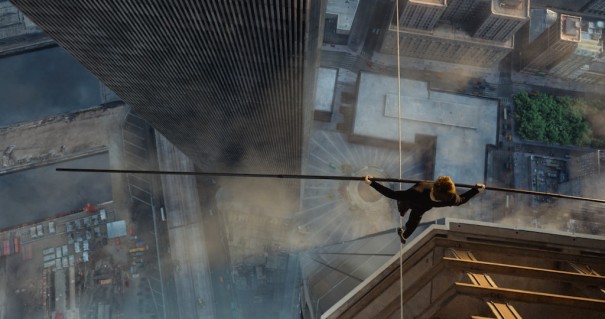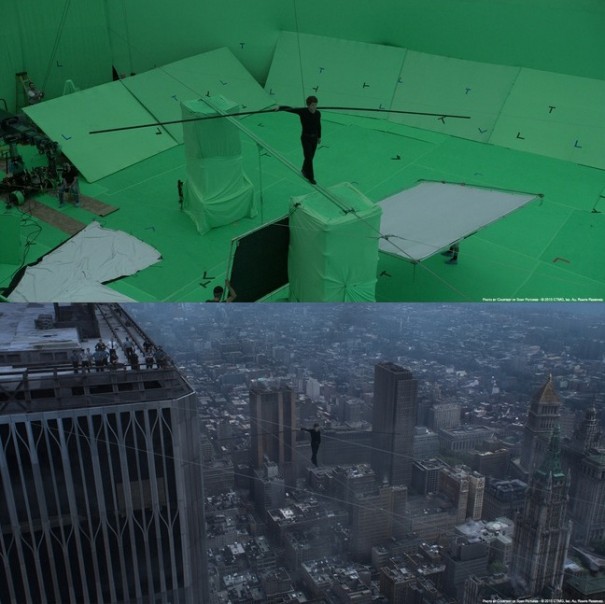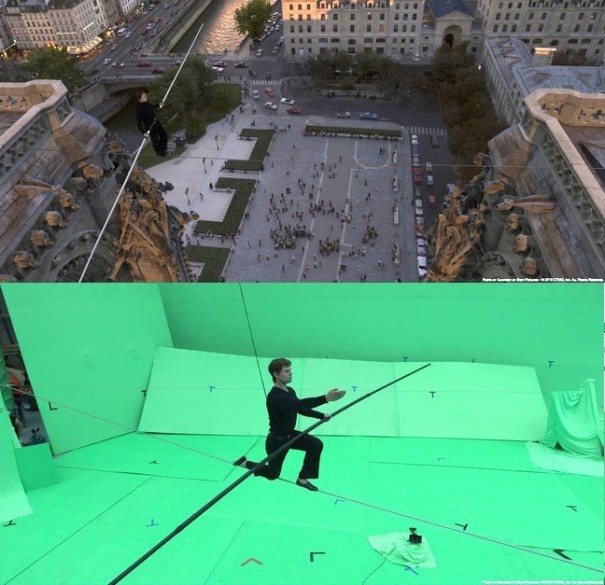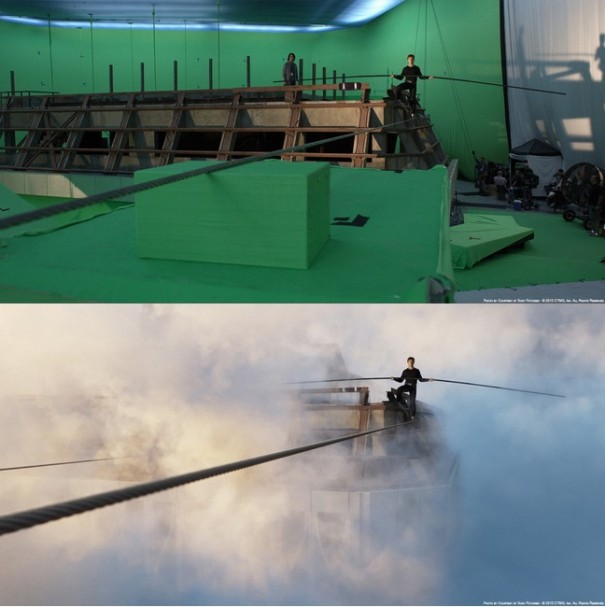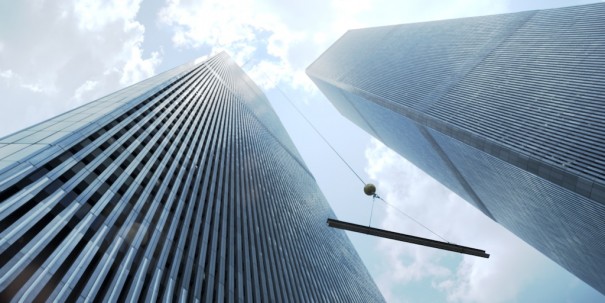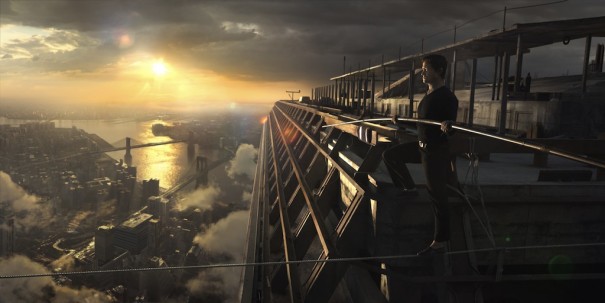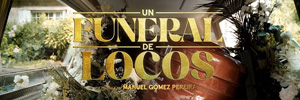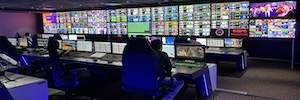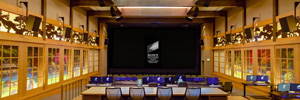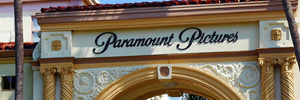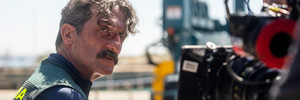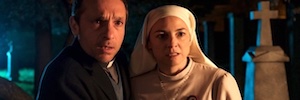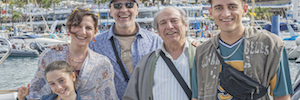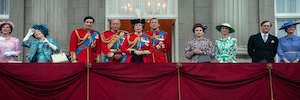‘El desafío (The Walk)’ llega a la gran pantalla con innovadoras técnicas fotorrealistas
La nueva película de Robert Zemeckis recrea desde cero, con ayuda de técnicas digitales, todo el mundo del Nueva York de 1974, tal como se vería a cientos de metros de altura, entre los dos míticos edificios desaparecidos.
Doce personas han pisado la Luna, pero únicamente un hombre ha recorrido, o recorrerá jamás, el inmenso vacío que separaba las dos torres del World Trade Center.
Robert Zemeckis, el veterano director de joyas del cine como Forrest Gump, Náufrago, Regreso al futuro, Polar Express and El vuelo (Flight), vuelve a valerse de la tecnología más avanzada puesta al servicio de una emotiva historia que gira en torno a los personajes. El desafío, que cuenta con innovadoras técnicas fotorrealistas y la magia del IMAX 3D, es un verdadera experiencia para disfrutar en la gran pantalla, una oportunidad para los espectadores de sentir de manera visceral la sensación de encontrarse entre las nubes.
La película de TriStar Pictures en asociación con LStar Capital está protagonizada por Joseph Gordon-Levitt, Ben Kingsley, Charlotte Le Bon, James Badge Dale. Dirigida por Robert Zemeckis.
Producida por Steve Starkey, Robert Zemeckis y Jack Rapke. el guion es de Robert Zemeckis & Christopher Browne, basado en el libro Alcanzar las nubes, de Philippe Petit.
Al frente de la fotografía ha estado Dariusz Wolski, ASC con Kevin Baillie como supervisor de efectos visuales.
Oda al World Trade Center
El 7 de agosto de 1974, el día antes de que Richard Nixon anunciara su dimisión, Philippe Petit, un funámbulo francés, sorprendió a la ciudad de Nueva York con un paseo sobre un cable colocado entre las torres del casi terminado y parcialmente ocupado World Trade Center. Transeúntes sin un segundo que perder frenaron en seco y alzaron la vista. Vieron lo imposible: un hombre bailando en lo alto, aparentemente en el aire.
Ahora, cuarenta años después, Zemeckis pone a los espectadores en la piel de Petit. La película ofrece a los aficionados al cine la oportunidad de ir donde un único hombre ha logrado o logrará jamás llegar: a 110 pisos de altura en el aire, sobre un cable, paseando entre las torres del World Trade Center.
Una perspectiva 3D
Zemeckis reconoce que “cuando descubrí esta historia, pensé: ‘Dios mío, esta es una película que A) debería hacerse fuera como fuera, y B) debería sin lugar a dudas presentarse en 3D. Cuando ves a un funámbulo, siempre tienes que hacerlo mirando hacia arriba. Nunca tienes la perspectiva de lo que se siente en la cuerda floja. Nuestra película sigue la historia de Petit y, al final, te pone sobre el cable, caminando con Philippe, y, al presentarla en 3D, va a resultar espectacular y muy emotiva”.
“Me asombró la pasión del sueño de Philippe y cómo logró cumplirlo. En cierto modo, guarda ciertas similitudes, para mí, con un productor que quiere hacer una película. Pero, por debajo de todo eso, está esa emocionante historia de un gran plan, y la tensión para ejecutar lo que Philippe llama su ‘golpe’. Al final, nos hace llorar a mí y a otros, algo similar a lo que viví cuando leí Forrest Gump”, opina el productor Steve Starkey.
La película no muestra únicamente quién era antes y cómo llegó a encontrarse en ese cable (su juventud, el hombre que se convirtió en su figura paterna, etc.), sino también, por primera vez, imágenes en movimiento del propio paseo en sí, no solo desde el punto de vista de los observadores, sino también del de Petit. “Las únicas pruebas documentales del paseo son unas cuantas fotografías”, explica Joseph Gordon-Levitt, que encarna a Petit en el filme de Zemeckis. “Las fotos son increíbles, pero no es lo mismo que ver y sentir cómo sucede. Para mí, hacer una película en la que puedes realmente meterte en el personaje de Philippe cuando vive ese momento, con todas las esperanzas, miedos e imperfecciones que condujeron hasta él, es algo excepcional. Tener ocasión de presenciar eso en una película y estar allí arriba con el personaje, ver lo que vio, es una experiencia totalmente distinta”.
De forma similar a como ya hiciera en “Forrest Gump”, al utilizar la particular voz del protagonista para reforzar la narración de esa película, Zemeckis hace que el propio Petit narre momentos de El desafío para aportar algo de perspectiva, sobre todo a sus más íntimos pensamientos mientras se encuentra sobre el cable. El uso ligeramente surrealista del recurso de la Estatua de la Libertad (como Petit, un regalo francés a Estados Unidos) para este fin ayuda a dotar de una cierta cualidad como de fábula a esta película para todos los públicos. “Se trata de una historia real”, afirma Zemeckis, “hasta el más mínimo detalle, pero también tiene un aire de ‘érase una vez’ (un tiempo y lugar perdidos) y quería combinar lo literal con lo figurado”.
Efectos visuales
Como corresponde a una producción así, el supervisor de efectos visuales Kevin Baillie se implicó muy temprano en El desafío . “Hace ya seis o siete años que formo parte del proyecto”, recuerda. “Robert y yo estábamos trabajando en Christmas Carol, pero ya tenía una gran idea para una película sobre un chiflado funámbulo francés que pretendía caminar por la cuerda floja entre las Torres Gemelas”.
El proyecto resultaba especialmente interesante para el supervisor de efectos visuales por el tremendo reto que suponía: habría que crear desde cero todo el mundo del Nueva York de 1974, tal como se vería a cientos de metros de altura, entre dos edificios que ya no están.
“Tenemos que hacerlo todo, desde el vestíbulo del World Trade Center al centro de Nueva York en 1974. El departamento de diseño de producción recreó en un plató gigantesco la azotea de una de las torres. Era un decorado enorme y absolutamente alucinante, pero la ciudad que tenía a su alrededor, la niebla que se arremolinaba en torno a las torres, las propias torres que se alzaban por encima de la ciudad, había que crearlas todas de forma completamente digital, a partir de referencias fotográficas. Evidentemente, estos edificios ya no existen, por desgracia, pero tenían que parecer totalmente reales y presentes al 1000%, porque son el corazón emocional de la película. No ha sido hasta hace muy poco cuando la tecnología ha evolucionado hasta llegar al punto en que esto, aunque complicado, es posible. Y solamente en el cine. Curiosamente, por ejemplo, nos encontramos con que diferentes personas recordaban de forma distinta su color, porque cambiaba según el ángulo con que les diera el sol. Queremos honrar y hacer justicia a esos edificios, por esos recuerdos, pero también porque lo que Philippe hizo entre ellos fue precioso”, explica Baillie.
De este modo, El desafío transporta a los espectadores a un momento del tiempo en el que a las torres, o, al menos, a la percepción que se tenía de ellas, se les dio una nueva orientación. “Al principio, las Torres Gemelas no le gustaban a nadie. Mientras las construían, todo el mundo en Nueva York pensaba que parecían archivadores. Después de que se produjera este paseo, a la gente le encantaban las torres. Tenían personalidad. Cuando Philippe Petit caminó entre ellas, de pronto se volvieron poéticas y sufrieron una transformación”.
“Las torres están muy presentes en la película como personajes”, agrega Zemeckis. “Este fue uno de esos momentos humanos y gloriosos. Es importante recordar eso”.
A lo largo de su legendaria carrera, Zemeckis ha hecho filmes que han sabido aprovechar la tecnología más avanzada para ponerla al servicio de la historia. Para Zemeckis, esto último es lo más importante; la tecnología es una herramienta, como cualquier otra técnica, de la que puede valerse el cineasta. “El secreto de cualquier magia es saber combinar”, propone. “Todo gran mago utiliza más de una técnica para crear la ilusión. La labor del cineasta es hacer también eso, utilizar todas las herramientas de las que disponemos y no dejar de combinarlas, para que los espectadores no puedan descubrir el truco”.
Recrear el World Trade Center
“No pudimos rodar entre las dos torres del World Trade Center, por supuesto, porque, por desgracia, ya no existen, pero pudimos replicarlas de tal manera que creo que es un homenaje hecho con un enorme afecto a esos edificios”, afirma Joseph Gordon-Levitt. “Bob se obsesionó con los edificios, con todos los detalles, y, en ese aspecto, recordaba a Philippe, porque Philippe se obsesionó con esos edificios en 1974, cuando aún los estaban construyendo. Podía decirte todos los distintos ascensores. Podía decirte las dimensiones, la altura y anchura, y qué distancia había entre las torres, de esquina a esquina. Resultó muy emotivo ver a Bob reconstruir con sumo cuidado y cariño esos edificios”.
Recrear las torres fue el mayor reto de producción que tuvieron que afrontar la diseñadora de producción Naomi Shohan y el supervisor de efectos visuales Kevin Baillie en El desafío. En última instancia, su trabajo es una combinación de un decorado enorme en un plató y meses de recreación digital.
El primer reto fue decidir qué construir físicamente y qué crear digitalmente. “Tuvimos que calcular qué metros cuadrados del set de la azotea nos permitirían obtener el mayor número de planos, sabiendo que habría bastantes planos”, recuerda Shohan. “Queríamos ser fieles, más que fieles. Queríamos homenajear las torres, su escala. Si no estás familiarizado con el lugar, es imposible apreciar la enormidad de la tarea”.
Valiéndose de los planos originales del World Trade Center, Shohan diseñó y construyó una enorme esquina de 12×18 metros de la torre sur, donde se desarrolla la mayor parte de la acción, ya que la historia sigue a Philippe durante el golpe. Aunque el equipo de rodaje también tenía que filmar lo que sucedía en la torre norte, podían apañarse con una sola esquina, ya que las dos torres eran casi idénticas, de modo que Shohan podía simplemente cambiar la decoración de la azotea y hacer los ajustes necesarios para que pareciera la esquina contraria.
El equipo de Shohan construyó una azotea estructuralmente sólida, algo que se hizo necesario dado que, por problemas de espacio, el lugar más práctico para recrear el piso 110 (una localización clave, en la que Philippe y Jeff se esconden durante horas) resultó ser justo debajo del set de la azotea.
Al final, Shohan y su equipo recrearon básicamente una cuarta parte de la azotea de 60×60 m del World Trade Center. Con ángulos de cámara creativos, eso fue a menudo suficiente. Sin embargo, para recrear el resto de la azotea, las torres y el Nueva York de 1974, visto desde el aire a más de 400 m de altura, Baillie y su equipo de efectos visuales de Atomic Fiction tuvieron que hacerse cargo del proyecto.
Para la torre, Baillie y su equipo contaron con los planos originales de cada planta del World Trade Center, así como con infinidad de referencias fotográficas. Sin embargo, su equipo y él tuvieron que hacer frente a un reto inesperado. “La torre en sí es algo engañosamente complicado de hacer que parezca real”, explica Baillie. “Es tan geométricamente simple, con esas líneas rectas que llegan hasta el suelo, que si la haces perfecta, resulta falsa. Tuvimos que crearla entera y luego descubrir cuál era la cantidad adecuada de defectos e imperfecciones que se le podían meter, como paneles ligeramente desalineados, o comprobar que la distancia entre los paneles no se mantiene perfectamente uniforme. También creamos unos 30 pisos de interiores, de modo que, si te fijabas bien, podías ver escritorios y sillas dentro”.
Más complicado aún para Baillie y su equipo fue la reconstrucción históricamente fiel del Nueva York de 1974, visto entre las dos torres desde más de 400 m de altura. “Nueva York en 1974 tenía un aspecto muy distinto al actual”, señala Baillie. “Tomamos un helicóptero y sobrevolamos Nueva York durante dos días para recoger imágenes reales de referencia del aspecto actual de la ciudad pero, al final, lo que se ve en la película está recreado digitalmente al 100%”.
Baillie y su equipo utilizaron como referencia todo el material que pudieron encontrar de la época, desde imágenes de Internet a fotografías de archivo de libros y bibliotecas, planos originales y mucho más. “Hay un sitio web muy bueno, con una barra deslizante que, si la arrastras hasta 1974, todo edificio nuevo desde 1974 aparece señalado en el mapa de azul”, aporta Baillie. “Nos sirvió un poco de chuleta. En definitiva, la mayoría de las fotos de referencia no son más que eso, referencia, y nuestros artistas las utilizaron para recrear los edificios de alrededor de forma completamente digital”.
En su mayor parte, el equipo de Baillie realizó los cálculos de cada uno de los edificios para hacerlos lo más precisos posible. “Incluso con edificios que no tenían planos, disponíamos al menos de medidas de la altura que tenían”, prosigue Baillie. Hasta los detalles –como el tamaño y configuración de las ventanas, por ejemplo– se basan, siempre que fuera posible, en esa documentación, y con los escasos edificios que ya no existen y de los que no había referencias fotográficas ideales de la época hubo que “extrapolar con inteligencia”.
La maqueta de Baillie está pensada fundamentalmente para verla tan solo desde arriba, o sea, desde el punto de vista de Petit durante su paseo. No obstante, dado que Zemeckis tenía previsto mostrar unos cuantos planos desde abajo –como, por ejemplo, desde la plaza del World Trade Center– estas zonas de la maqueta están completas y listas para explorarse, como si te estuvieras dando un paseo por la ciudad.
Al final, recrear las estructuras de la ciudad y las torres fue una tarea que llevó al “equipo de construcción” de 15 personas de Baillie tres meses completar –cuatro años/hombre–, tras lo cual un equipo de más de 100 artistas invirtieron cinco meses para integrar ese mundo digital con el metraje sobre croma verde filmado en el set de rodaje. “Hubo sin duda momentos en que la cosa se puso muy emotiva, tanto para mí como para el equipo”, recuerda. “Al revisar las fotografías de referencia, vimos muchas imágenes del 11-S, porque son evidentemente las imágenes más recientes que se pueden encontrar de las torres. Así que creo que sentimos una gran responsabilidad por mostrar las torres de una forma que fuera sincera, pero al mismo tiempo sirviera de homenaje”.
“La otra emoción que sentimos fue puro entusiasmo”, prosigue Baillie. “Lo sentí de verdad, después de terminar el rodaje, cuando me pasé dos días en un helicóptero sobrevolando la Zona Cero a algo más de 400 m de altura. Volábamos exactamente por donde se encontraba Philippe caminando por el alambre. Hace que se te ericen los pelos del cogote, solo de pensarlo. Me encontraba exactamente en el mismo lugar en el que ese tipo se dio su paseo, sin sistema alguno de seguridad; al mirar abajo, me quedé atónito. Fue estupendo vivir esa experiencia, por el material de referencia que pudimos captar, pero también por la sensación emocional, la impresión de la altura y el peligro que conlleva. Así pudimos asegurarnos de que cada plano que incluyéramos en la película transmitiera esa misma sensación. Francamente, no creo que las imágenes que tenemos en el filme hubieran sido tan buenas de no haber estado yo allí para experimentar lo que se siente”.
Todo un desafío visual
Además de recrear el World Trade Center y la ciudad de Nueva York, el supervisor de efectos visuales Kevin Baillie tuvo que hacer frente a muchas responsabilidades más para que El desafío quedara lo más perfecta posible.
Para la secuencia del paseo en sí, Baillie señala que, por impresionante que fuera la proeza de Gordon-Levitt de aprender funambulismo, los efectos visuales pudieron echar una mano de dos formas. “Para lo más sencillo, Joe dio él mismo el propio paseo, lo que fue asombroso”, opina. “Para algunas de las cosas más complicadas, como cuando se tumba, o cuando se pone la pértiga sobre la espalda, el alambre se colocó en una viga de acero verde de 6 m de longitud. Cuando ves las propias imágenes grabadas, está caminando por una superficie de 15 cm de anchura, con el alambre en mitad de la misma, pero, después de borrar todo el verde, parece que se encuentre directamente sobre un alambre”.
Naturalmente, el verdadero Philippe Petit contó con años de preparación para realizar esta proeza, mientras que Gordon-Levitt no tuvo más que ocho días. Así que no poseía la capacidad necesaria para realizar ciertas maniobras más técnicas sobre el alambre. Para estas, el equipo de la película empleó a un doble, Jade Kindar-Martin, que es uno de los funámbulos más consumados del país –un tipo que se casó con su mujer en la cuerda floja y que, por absoluta y fabulosa coincidencia, se formó con Rudy Omankowsky, Jr., hijo de Papa Rudy, que enseñó a Philippe Petit. “Sacamos una foto y pusimos tanto a Philippe como a Jade al teléfono con Papa Rudy, Jr., que estaba entusiasmado de que estuviéramos haciendo la película”, recuerda Starkey. “Jade continuó con la preparación de Joe que había iniciado Philippe antes del rodaje. Los sábados, venían y seguían practicando, y Joe acabó aprendiendo a cruzar la torre”.
Kindar-Martin también realizó las acrobacias sobre el alambre que quedaban más allá de la capacidad de Gordon-Levitt. El departamento de efectos visuales estaba presente para asegurar que su interpretación encajara a la perfección con la de Gordon-Levitt. “Había unas cuantas maniobras verdaderamente complicadas que únicamente un verdadero funámbulo puede realizar, como arrodillarse en el alambre y saludar con la mano, o los giros más complicados, o hacer malabarismos con antorchas encendidas en una cuerda floja”, reconoce Baillie. “Por mucho talento que tenga Joe, son cosas que no puede hacer. Jade, el doble, se encargaba de realizarlas y luego le cambiamos la cara. Escaneamos el rostro de Joe en 43 poses distintas, para que pudiéramos grabar todos los movimientos musculares de los que es capaz su cara. Pudimos imitar el gesto de concentración y determinación que tendría Joe si estuviera ejecutando esa maniobra en el alambre”.
El desafío se filmó en 2D y los expertos de Legend3D se encargaron de convertirla a 3D. Aunque no hace tanto las conversiones a 3D acarreaban un estigma muy negativo, Baillie declara que ahora: “No volveré a hacer una película de ninguna otra manera. Es un proceso increíble y creo que queda mejor que rodar una película con dos cámaras, porque puedes ajustar la profundidad para ayudar a los espectadores a sentir la emoción concreta que le interesa al director. No tienes que ceñirte a la realidad, puedes hacer lo que hace el ojo humano, de todos modos, que es filtrar información para crear una versión modificada de la realidad que tus ojos transmiten luego a tu cerebro”.
El filme se concibió como una película 3D y Baillie asegura que todo el equipo tuvo mucho cuidado, desde la preproducción hasta la posproducción, de tomar decisiones que quedaran bien en 3D. “Por ejemplo, usamos una amplia profundidad de campo para el foco, lo mantuvimos todo enfocado, en la medida de lo posible”, explica Baillie. “Bob también estaba encantado de poder usar planos largos y amplios, en lugar de cortes rápidos. Normalmente, una película puede tener algo más de 2000 planos, pero El desafío no tiene más que 826. Y Bob lo hizo adrede, para que los espectadores tuvieran oportunidad de absorber y explorar ese entorno 3D que están viendo”.
Making of
[youtube]https://www.youtube.com/watch?v=sbSdx412okM[/youtube]
Tráiler
[youtube]https://www.youtube.com/watch?v=b9aeEZ6COP0[/youtube]
Did you like this article?
Subscribe to our NEWSLETTER and you won't miss a thing.



